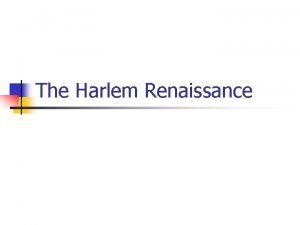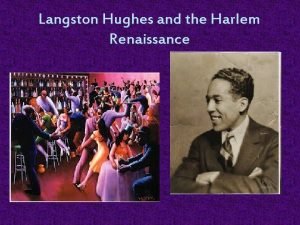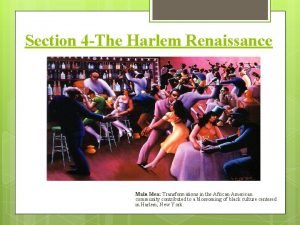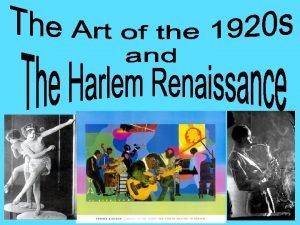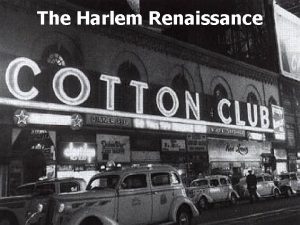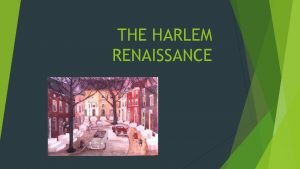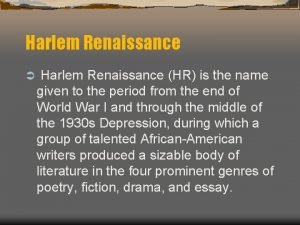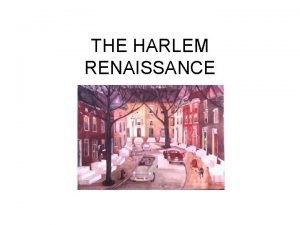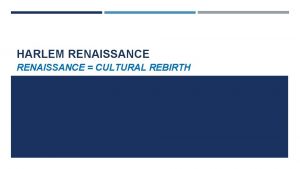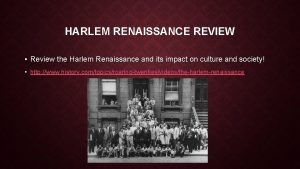The Harlem Renaissance Harlem Renaissance The Harlem Renaissance











- Slides: 11

The Harlem Renaissance

Harlem Renaissance • The Harlem Renaissance was an African American cultural movement of the 1920 s and early 1930 s centered around the Harlem neighborhood of New York City. [Grocery store, Harlem, 1940] Library of Congress Prints and Photographs Division Washington, D. C. ; LC-USZC 4 -4737

• The Harlem Renaissance marked the first time that mainstream publishers and critics took African American literature seriously and African American arts attracted significant attention from the nation at large. • African American writers intended to express themselves freely, no matter what the public thought. Harlem Renaissance

• During a phenomenon known as the Great Migration, hundreds of thousands of African Americans moved from the economically depressed rural South to the industrial cities of the North, taking advantage of employment opportunities created by World War I. Harlem Renaissance

• As more and more educated African Americans settled in New York’s neighborhood of Harlem, it developed into the political and cultural center of black America. Harlem Renaissance

• African American literature and arts surged in the early 1900 s. • In 1926 a new generation of young writers and artists, including Langston Hughes, Wallace Thurman, and Zora Neale Hurston, took ownership of the literary Renaissance. Harlem Renaissance

• Their goal was to give artistic expression to the African American experience in both Africa and the American South. • From the mid-1920 s through the mid-1930 s, about 16 African American writers published over 50 volumes of poetry and fiction, while dozens of other African American artists made their mark in painting, music, and theater. Harlem Renaissance

Harlem Renaissance • The diverse literary expression of the Harlem Renaissance was demonstrated through Langston Hughes’s weaving of the rhythms of African American music into his poems of ghetto life, as in The Weary Blues (1926). Langston Hughes Library of Congress, Prints & Photographs Division, FSA/OWI Collection, [reproduction number, e. g. , LC-USF 34 -9058 -C]

Harlem Renaissance • Diversity was also demonstrated through Zora Neale Hurston’s novels such as, Their Eyes Were Watching God (1937). Hurston used life of the rural South to create a study of race and gender in which a woman finds her true identity. [Portrait of Zora Neale Hurston] Library of Congress, Prints & Photographs Division, Carl Van Vechten Collection, [reproduction number, e. g. , LC-USZ 62 -54231]

Harlem Renaissance • The existence of the large amount of literature from the Renaissance inspired writers such as Ralph Ellison and Richard Wright to pursue literary careers in the late 1930 s and 1940 s. New York, New York. Portrait of Richard Wright, poet Library of Congress, Prints & Photographs Division, FSA/OWI Collection, [reproduction number, e. g. , LCUSF 34 -9058 -C]

Harlem Renaissance • The writers that followed the Harlem Renaissance found that American publishers and the American public were more open to African American literature than they had been at the beginning of the twentieth century. • The outpouring of African American literature in the 1980 s and 1990 s by such writers as Alice Walker, Toni Morrison, and Spike Lee had its roots in the writing of the Harlem Renaissance.
 The harlem renaissance: mastery test
The harlem renaissance: mastery test Daily life during the renaissance
Daily life during the renaissance Define harlem renaissance
Define harlem renaissance Crash course harlem renaissance
Crash course harlem renaissance The harlem renaissance main idea
The harlem renaissance main idea Harlem renaissance webquest
Harlem renaissance webquest The roaring 20s were characterized by
The roaring 20s were characterized by Harlem renaissance flappers
Harlem renaissance flappers Harlem renaissance easy definition
Harlem renaissance easy definition Bessie smith harlem renaissance
Bessie smith harlem renaissance Harlem renaissance
Harlem renaissance Harlem renaissance brainpop answers
Harlem renaissance brainpop answers


